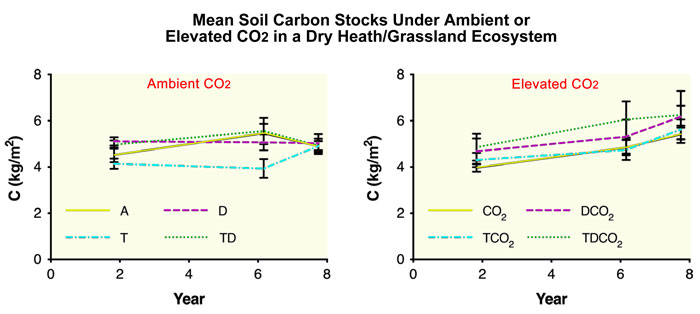| Tweet | Follow @co2science |
Paper Reviewed
Dietzen, C.A., Larsen, K.S., Ambus, P.L., Michelsen, A., Ardnal, M.F., Beier, C., Reinsch, S. and Schmidt, I.K. 2019. Accumulation of soil carbon under elevated CO2 unaffected by warming and drought. Global Change Biology 25: 2970-2977.
One of the fears related to projections of future CO2-induced global warming is that rising temperatures will stimulate microbial decomposition of soil carbon, which will increase rates of soil respiration and release CO2 into the atmosphere, potentially producing a positive feedback to rising global temperatures. However several experimental research studies manipulating temperature and CO2 have indicated this hypothesis is not correct. The latest work to do so comes from Dietzen et al. (2019).
Writing in the journal Global Change Biology, the eight scientists conducted an eight year field study at a site in Brandbjerg, Denmark, of a dry heath/grassland ecosystem dominated by two perennial species, a grass (Deschampsia flexuosa) that dominates with approximately 70% cover and an evergreen dwarf shrub (Calluna vulgaris) that accounts for the remainder. There, Dietzen et al. utilized a multifactor design approach to investigate the effects of elevated CO2, warming and drought on soil carbon stocks to a depth of 30 cm. Atmospheric CO2 enrichment was administered to a target value of 510 ppm via a free-air CO2 enrichment (FACE) design from dusk until dawn, but was not applied during periods of complete snow cover. Warming was achieved via the use of curtains that reflected infrared radiation back to the soil surface, which effectively warmed the soil temperatures by 0.4°C during the summer and 0.2°C in the winter. Drought periods were introduced one or two times each year in the spring or summer by excluding rainfall via exclusion curtains during rain events, which exclusion was continued until the soil water content fell below 5% in the upper 20 cm of the soil profile, at which point rewetting was allowed so as to maintain soil moisture above the wilting point. Drought periods typically lasted between 1 and 5 weeks, which corresponded to the typical drought period that occurs naturally at the site.
So what did the study reveal?
As shown in the figure below, Dietzen et al. report that "elevated CO2 had a positive effect on soil carbon stocks in the studied temperate heath-grassland," increasing soil carbon by 18.8% between year 2 and year 8. And yet this CO2-induced increase could ultimately be a conservative estimate, for according to the authors, when pretreatment data were considered (i.e., soil carbon measurements made prior to the start of the experiment), it was determined that the elevated CO2 plots initially contained substantially less carbon than the ambient plots (3.91 vs 5.06 kg C/m2). Thus, the actual increase in soil carbon due to elevated CO2 was a much larger 50.1% when factoring in this difference.
Dietzen et al. also report that, contrary to fears of a positive feedback under rising temperatures, the "observed increase in soil carbon due to the stimulating effect of elevated CO2 on belowground plant growth was not diminished by either drought or warming, signifying that elevated CO2 had a stronger effect on soil carbon than either of these climatic variables" And because of this fact, the authors conclude that, "given the lack of significant interactions between treatments, our results suggest that moderate changes in warming and drought are unlikely to modify the rate of increase in soil carbon stocks under elevated CO2." Consequently, they add that this site (and likely sites elsewhere around the globe) is "expected to store more carbon under future climate conditions, serving as a negative feedback to elevated atmospheric CO2 concentrations."

Figure 1. Mean soil carbon (C) stocks for each of the eight individual treatments under ambient CO2 (left panel) and elevated CO2 (right panel). Error bars indicate 1 SEM. Treatments include: ambient control (A), drought (D), warming (T), warming + drought (TD), elevated CO2 (CO2), drought + elevated CO2 (DCO2), warming + elevated CO2 (TCO2), and warming + drought + elevated CO2 (TDCO2). Source: Adapted from Dietzen et al. (2019).




